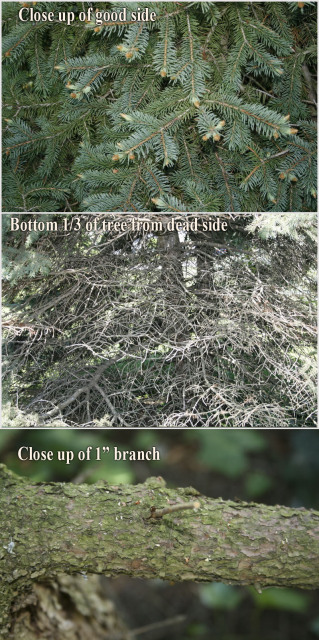Question
 Spruce
Spruce
Sorry, Jim, I submitted this question a moment ago without the photo attached.
Hello Jim,
I have a tree that I'm worried about. I think it is a Blue Spruce, about a 20 years located in Northern Ohio. Part of tree began looking a little dry last summer/fall when we had a long spell of hot dry weather. But this spring I find about 20% of the branches on one side of the tree are just plain dead. I have two other trees of this type and wonder if it is disease, I'd hate to lose them all, or even this one.
I have attached three photos, one of the dead side, one of the healthy side, and a closeup of one of the smaller branches that is close to the trunk of the tree and I submit them to your consideration. I've cut away everything that is completely dead (assuming that was a good thing to do) and I left anything that seemed flexible even if no leaves were present. I'm asking if you have any advice that I may follow to help make this tree happy again.
Many thanks for your thoughts and consideration. I do appreciate your time and knowledge.
Bill
AnswerLooks like a disease.
The most important disease of spruce in landscape plantings is Cytospora canker. This disease is caused by a fungus and is frequently found on Norway spruce and Colorado blue spruce and its cultivars. White spruce is also susceptible and there are a few reports on Serbian spruce. In addition to the spruces, Cytospora canker is sometimes found associated with Douglas fir, hemlocks, larches, and balsam fir.
Dying of a lower branch with subsequent needle browning is usually the first symptom. The brown needles may remain on the branches or they may fall off. As the disease progresses over several years, higher branches show damage. The actual cankers are often first seen at the base of branches near the main trunk of the tree. On the more susceptible species (Norway spruce), trunk cankers develop which may result in girdling and death of the tree.
The bark of the cankered areas is not visibly different in color, nor does it become sunken as in cankers on many deciduous trees. However, resin flow is usually associated with Cytospora canker and the white patches of dried resin are quite conspicuous on the bark. Resin flow can, however, be associated with any injury to branch tissue.
Cankers often cannot be located without cutting into the bark. Removal of the outer bark from cankers reveals brown, dead areas of the inner bark and cambium. Within the cankered areas, a careful search using a magnifying hand lens will often reveal black pinhead sized structures that produce the spores of the pathogen. Careful removal of layers of bark make these structures even more visible. During wet weather, yellow to orange colored masses of spores oozing out of these black structures in tiny tendrils can be observed. Sometimes these tendrils or gelatinous spore masses are visible to the unaided eye.
Cytospora canker is more common on trees over 15 years old. This disease is more prevalent on trees of low vigor. Those trees with shallow roots, weakened by drought, low fertility, mechanical injury, or insect damage; and trees growing in an unfavorable site are more susceptible to Cytospora canker. The following practices lessen the likelihood of this disease.
Fertilize the tree with 10-10-10 fertilizer at the rate of 1 lb per inch of trunk diameter scattered around the tree and watered in good. Apply the fertilizer just before a rain storm and you will not need to water.
water during dry spells with 1 inch of water per week--place a pan under the tree and turn the sprinkler on and when the pan has 1 inch of water in it stop.
Once established, the following may aid in suppressing disease development. Remember that affected branches cannot be saved.
Prune and remove or destroy affected branches. To lessen the spread of the fungus, prune only when the trees are dry. Pruning tools should be disinfected with 70% alcohol between cuts. It will generally be necessary to prune back to the main trunk. No effective chemical control measures are available.






